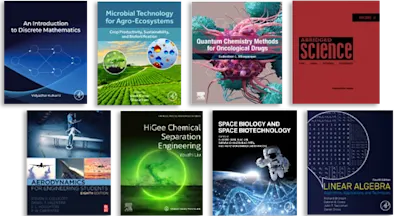
Methods in Biomolecular Modelling
- 1st Edition - May 1, 2026
- Latest edition
- Editor: Thomas W. Keal
- Language: English
- Paperback ISBN:9 7 8 - 0 - 4 4 3 - 2 2 0 4 1 - 8
- eBook ISBN:9 7 8 - 0 - 4 4 3 - 2 2 0 4 0 - 1
Methods in Biomolecular Modelling considers modeling methods with relevance to the study of biomolecular systems, including the workhorse of classical molecular dynamics and relate… Read more
Purchase options

Methods in Biomolecular Modelling considers modeling methods with relevance to the study of biomolecular systems, including the workhorse of classical molecular dynamics and related techniques, areas where electronic structure methods find use, the higher length scales achievable through coarse grained and mesoscale methods, and combinations of scales. Applicability of methods is then illustrated with a wide range of biomolecular modeling research topics drawn from current research. Throughout the text, practical considerations of research are emphasized, including sourcing of structural data, scalability of methods on HPC systems, and linking of computation to experiment.
Part I introduces a range of modeling techniques used for biomolecular simulation, explaining the fundamental principles of each and the research areas to which they are applicable. The strengths and weaknesses of each method are outlined, along with their real-world performance on current computing resources and future trends. Part II looks at a range of application areas, with case studies illustrating the methods that can be used to investigate biomolecular systems in these areas.
Part I introduces a range of modeling techniques used for biomolecular simulation, explaining the fundamental principles of each and the research areas to which they are applicable. The strengths and weaknesses of each method are outlined, along with their real-world performance on current computing resources and future trends. Part II looks at a range of application areas, with case studies illustrating the methods that can be used to investigate biomolecular systems in these areas.
- Introduces a range of modeling techniques used for biomolecular simulation, explaining the fundamental principles of each and the research areas to which they are applicable
- Includes an overview of what can be done using existing methods on current computer architectures
- Covers practical considerations in research in these areas, including sourcing of structural data, scalability of methods on HPC systems, and linking of computation to experiment
- Provides balanced explanations of the limitations of certain approaches to help beginners become confident in deciding what method to use to investigate a certain problem
Undergraduates and postgraduates who would like to understand how different biomolecular simulation techniques may be applied to a range of research topics in biochemistry and biophysics; graduate students and researchers predominantly in computational and theoretical chemistry as well as materials science and biomolecular science, who are seeking to use and understand molecular modelling methods and approaches for the first time; experimental scientists who are seeking to use computational techniques to complement experimental studies; industrial researchers who wish to become acquainted with biomolecular simulation techniques, for example in pharmaceutical and biotechnology R&D
Part 1: Introduction to Biomolecular Simulation Methods
1. Molecular Dynamics with Biomolecular Force Fields
2. Free Energy Calculations
3. Enhanced Sampling Methods
4. Density Functional Theory and Ab Initio Molecular Dynamics
5. QM/MM Methods
6. Coarse Graining methods
7. Machine learning methods for biomolecules
8. The use of experimental data in biomolecular simulations
Part 2: Applications of Biomolecular Modelling
9. Protein-Ligand Interactions
10. Membrane proteins
11. Glycans and Glycoproteins
12. Intrinsically disordered proteins
13. Enzymatic reactivity
14. Nucleic acids
15. Macromolecular complexes
16. Photochemistry of biomolecules
17. Biological membranes
18. Biomaterials
19. Drug Design and Development
20. Computational Virology
1. Molecular Dynamics with Biomolecular Force Fields
2. Free Energy Calculations
3. Enhanced Sampling Methods
4. Density Functional Theory and Ab Initio Molecular Dynamics
5. QM/MM Methods
6. Coarse Graining methods
7. Machine learning methods for biomolecules
8. The use of experimental data in biomolecular simulations
Part 2: Applications of Biomolecular Modelling
9. Protein-Ligand Interactions
10. Membrane proteins
11. Glycans and Glycoproteins
12. Intrinsically disordered proteins
13. Enzymatic reactivity
14. Nucleic acids
15. Macromolecular complexes
16. Photochemistry of biomolecules
17. Biological membranes
18. Biomaterials
19. Drug Design and Development
20. Computational Virology
- Edition: 1
- Latest edition
- Published: May 1, 2026
- Language: English
TK
Thomas W. Keal
Thomas Keal is a Principal Scientist in the Computational Chemistry Group at STFC Daresbury Laboratory and Honorary Professor at the UCL Department of Chemistry, UK. His research interests are in multiscale QM/MM methods and their application to problems in biomolecular and materials modelling. He completed his PhD in 2005 in the group of David Tozer at Durham University, focussing on the development of new exchange-correlation functionals for density functional theory. He then moved to a postdoctoral position in the group of Walter Thiel in Mülheim an der Ruhr, Germany, working on methods for excited state optimisation and dynamics of biomolecules. He joined Paul Sherwood’s group at Daresbury in 2008 to continue work on methods development in the ChemShell QM/MM software package, and now leads the team developing ChemShell, which is widely used in the investigation of biomolecular reaction mechanisms.
Affiliations and expertise
Scientific Computing Department, STFC Daresbury Laboratory, UK